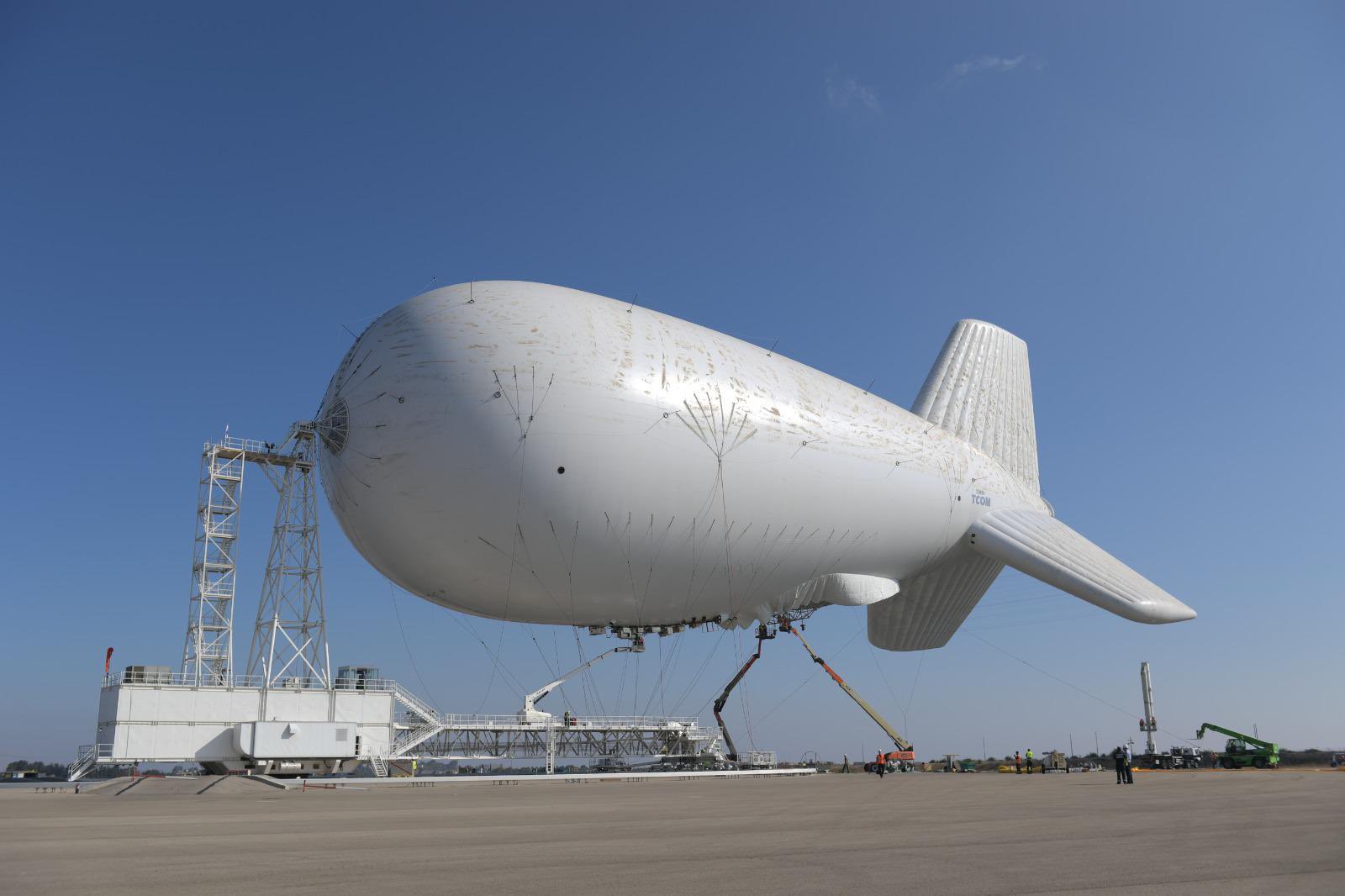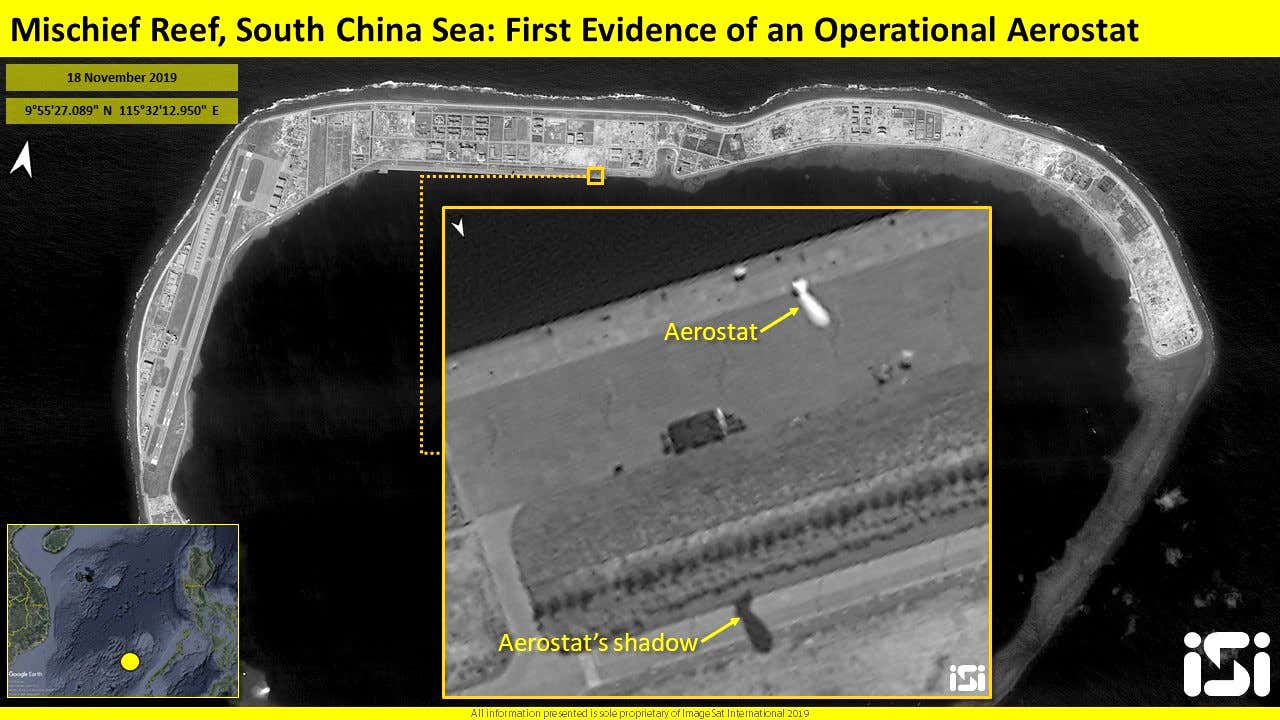Israel has launched a new early-warning aerostat, a type of unmanned tethered airship, described as one of the largest of its kind in the world. Developed by Israeli industry with U.S. assistance, the High Availability Aerostat System, or HAAS, will be expected to provide advance warning of low-flying threats, such as cruise missiles, weaponized drones, and other aerial threats. The general concept is well established in Israel, where the successful deployment of surveillance balloons of this kind to track low-flying threats, in particular, is in stark contrast to the U.S. Joint Land Attack Cruise Missile Defense Elevated Netted Sensor System, or JLENS, a multibillion-dollar program that was ignominiously canceled in 2017.
In a tweet yesterday, the Israeli Air Force (IAF), which will be responsible for operating HAAS, announced the introduction of the high-altitude aerostat after several years of development. Stationed at an unnamed location in northern Israel, the platform will be used “to detect and warn of advanced threats,” with its primary sensor being the long-range Sky Dew elevated radar. At this stage, the HAAS is still under test, with the milestone yesterday referring to the initial inflation of the aerostat’s gas envelope after installation of the radar equipment. While we are awaiting details of the specifications of the aerostat, its immense size is immediately clear by comparison to the cranes and other vehicles seen in the video below:

“The Sky Dew system will be a significant component in strengthening the protection of the country’s borders in the face of a variety of threats and will contribute to the capabilities of building a more accurate and broader picture of the airspace,” said Maj. Gen. Amikam Nurkin, commander of the IAF.
The IAF confirmed that the HAAS was developed by the Elta division of Israel Aerospace Industries (IAI) in cooperation with the IAF, the Israel Missile Defense Organization (IMDO), and the U.S. Missile Defense Agency (MDA). The balloon itself was produced by the American TCOM company, a specialist in this field that also produced the aerostat for JLENS.

“In several flight test campaigns conducted in recent months, we have demonstrated the outstanding capabilities of Israel’s multi-tier missile defense — including against cruise missiles,” explained Moshe Patel, director of the IMDO. “The IMDO and MDA, together with the IAF and defense industries are constantly improving Israel’s threat-detection capabilities.”
While smaller sensor-equipped aerostats are a familiar feature of military operations around the world, typically providing localized surveillance for forward bases in conflict zones, for border areas, or other points of interest, large-size balloons with radar payloads are far less common. But they offer significant advantages, including their persistence — being able to remain on station for many days at a time. By avoiding ground clutter and topography, they are also able to surveil a wider portion of airspace, all the way from ground level up to high altitude, meaning they are especially useful for detecting low-flying threats. At the same time, their upper-altitude limits far outstretch those of ground-based radars, providing a far longer line-of-sight to the horizon.
The idea of using an aerostat to provide warning of incoming cruise missile attacks also underpinned the U.S. Army’s JLENS program, which ran between 1996 and 2017 but failed to provide an operational capability before being canceled amid delays and cost overruns. Prototypes of JLENS were fitted with either a VHF-band surveillance radar or an X-band fire control radar.

Though JLENS failed, including an embarrassing and widely publicized incident in which the aerostat broke free of its moorings in Aberdeen, Maryland, before floating across Pennsylvania, the U.S. Customs and Border Protection (CBP) does operate a network of smaller Tethered Aerostat Radar Systems (TARS) along portions of America’s southern borders.
Other countries have introduced similar aerostat-based long-range surveillance systems, including China, which has deployed aerostats that may carry radars above its man-made islands in the South China Sea.

Israel itself has sold tethered aerostats with radars to other countries, including IAI’s ELM-2083 with its L-band active electronically scanned array (AESA). The manufacturer claims it is able to track up to 500 targets, with a detection range of more than 135 nautical miles against a fighter-sized target and coverage from the ground up to 24,000 feet. Customers for the ELM-2083 include India and Singapore, the latter at least using it in conjunction with a TCOM-designed balloon.
For the IAF, providing persistent, multi-directional airspace surveillance from its high-altitude perch, the HAAS will be able to detect different threats at long range, and at low level, with targeting data then fed into Israel’s multi-layered air defense architecture, essentially complementing any existing sensors within the ground-based surveillance network, as well as airborne sensors mounted on planes and drones.
In addition to manned fighter jets, the cutting edge of the Israeli air-defense system includes missile systems ranging from the Arrow 3 ballistic-missile defense system down to the Iron Dome that can counter rockets, artillery shells, and mortar rounds, and which is increasingly also expected to tackle more sophisticated threats. All these systems and more would potentially benefit from the additional surveillance capacity offered by an aerostat-based radar, especially against the kinds of low-flying threats that might leak through traditional radar coverage.
Official Israeli Ministry of Defense video of the Iron Dome air defense system in action:

Israel is keenly aware of the potential of cruise missile attacks from regional adversaries, chief of which is Iran, as well as potentially non-state actors. Israel’s most immediate adversaries, especially the terrorist groups Hamas and Hezbollah, have made significant strides in recent years in expanding and improving their own rocket and missile arsenals, which presents new challenges for the country’s entire multi-tier missile-defense architecture. But there is a growing risk that those groups, and others in the region, are fielding new systems, among them suicide drones and cruise missiles, which Iron Dome may not be best equipped to respond to in its present form. That realization has driven efforts to expand the target sets for the Iron Dome and perhaps also the development of HAAS.
It’s notable that the Iron Dome has already demonstrated a burgeoning ability to engage cruise missiles and small drones, as well as low-flying aircraft. The U.S. Army has recently acquired the Iron Dome with a view to using it to provide localized defense against incoming cruise missiles on the island of Guam, recognizing one of the most prominent threats outlined in the Pentagon’s last Missile Defense Review.
As well as their specific application in defense against cruise missile attacks, radar-toting aerostats like the HAAS contribute more generally to improved situational awareness. For a relatively small country like Israel, faced by a wide variety of different threats and surrounded by potential flashpoints, advanced warning of this kind is always going to be in demand.
The HAAS could also help counter the more familiar kinds of threats posed by the Hamas militant group in Gaza, as well as the Hezbollah group in Lebanon. These are armed with significant arsenals of rockets that are capable of hitting major cities in Israel. During the Gaza conflict earlier this year, barrages of rockets were fired in an effort to overwhelm Israeli air defenses. The Iron Dome system saw extensive use during the 11-day conflict, and The War Zone discussed its performance in depth at the time. In addition, these militant groups are making increasing use of unmanned aerial vehicles including suicide drones carrying explosive payloads.

However, placing the HAAS in northern Israel suggests that the main concern may be threats approaching from Syria, Iraq, Iran, and Lebanon, rather than from Gaza. In Lebanon in particular, the Iranian-backed Hezbollah group has an enormous and sophisticated arsenal of missiles and drones, with the range to reach Israel. It’s also notable that Israel has placed blame on Iran more directly in the last year in relation to longer-range attempted drone strikes and the threat posed by drone strikes launched by Iranian proxies in Iraq or Syria has been increasingly discussed. At the same time, the mountainous terrain of the north of the country would generally appear better suited to an elevated top-down-looking radar such as Sky Dew.
A primary mission of JLENS was to protect Washington, D.C., from cruise missile attack, which remains a major concern. It’s also worth bearing in mind that, while we don’t know the detailed capabilities of HAAS, JLENS was billed as being able to monitor the airspace from Virginia to New York or Boston, along a front that was some 500 miles long. Israel’s territory doesn’t stretch more than 500 miles at its longest point, so locating it in northern Israel could well provide coverage in other directions.
The ability to remain aloft for extended periods, normally in different types of weather, means that surveillance aerostats like HAAS can offer cost-effectiveness and reduced maintenance demands, especially compared with airborne early-warning aircraft. On the other hand, we don’t know how much has been invested in the Israeli program so far and, as JLENS demonstrates, this can be a highly expensive capability to realize. There have been reports suggesting that development was paid for “almost entirely” by the U.S. government, via Foreign Military Financing.
Nevertheless, Israel seems convinced that large-size aerostats offer an important adjunct to its already powerful air-defense network. As the HAAS heads toward operational service, it will be interesting to see whether other countries adopt similar solutions as they seek to counter similar low-flying threats.
Contact the author: thomas@thedrive.com
